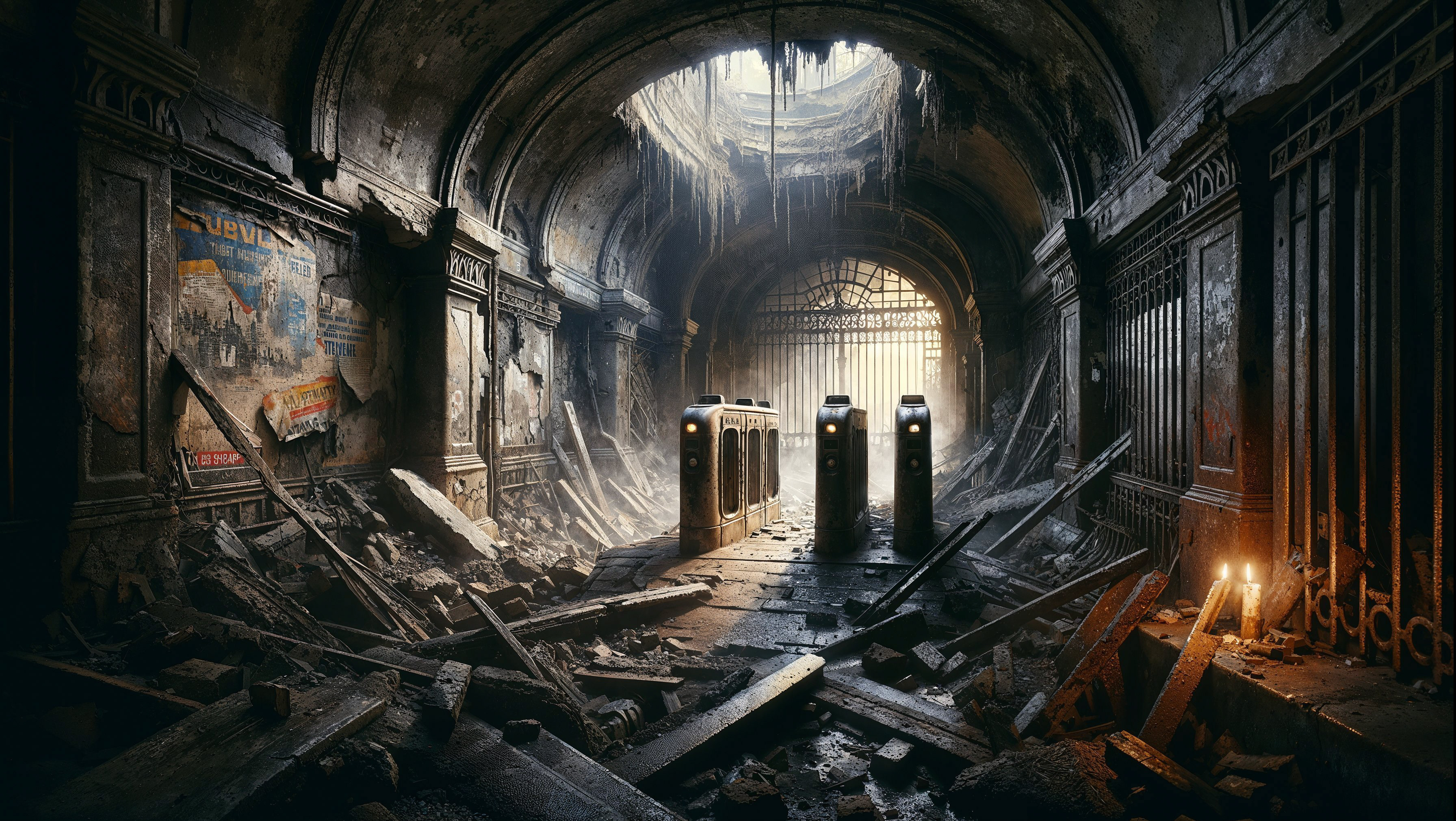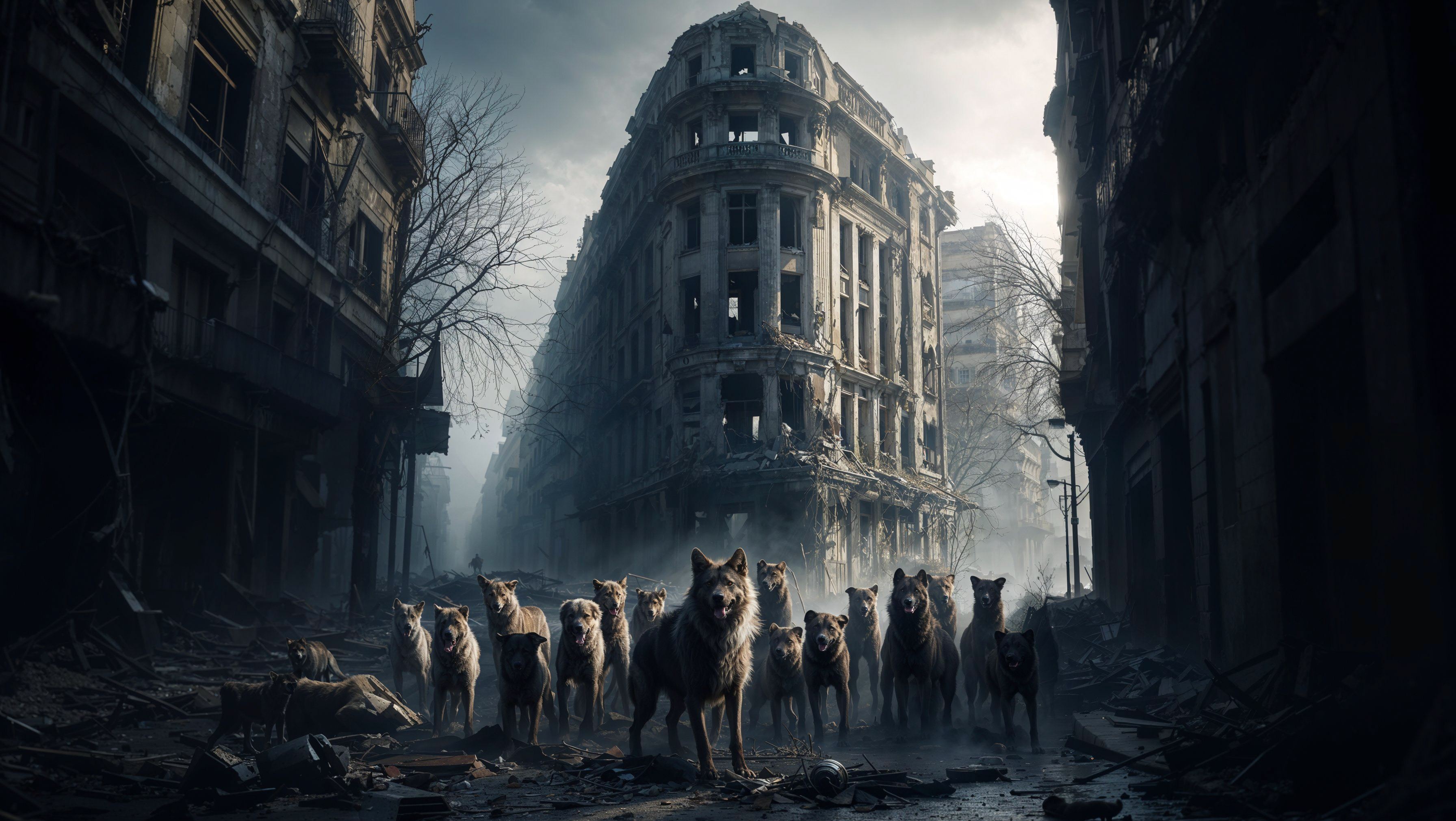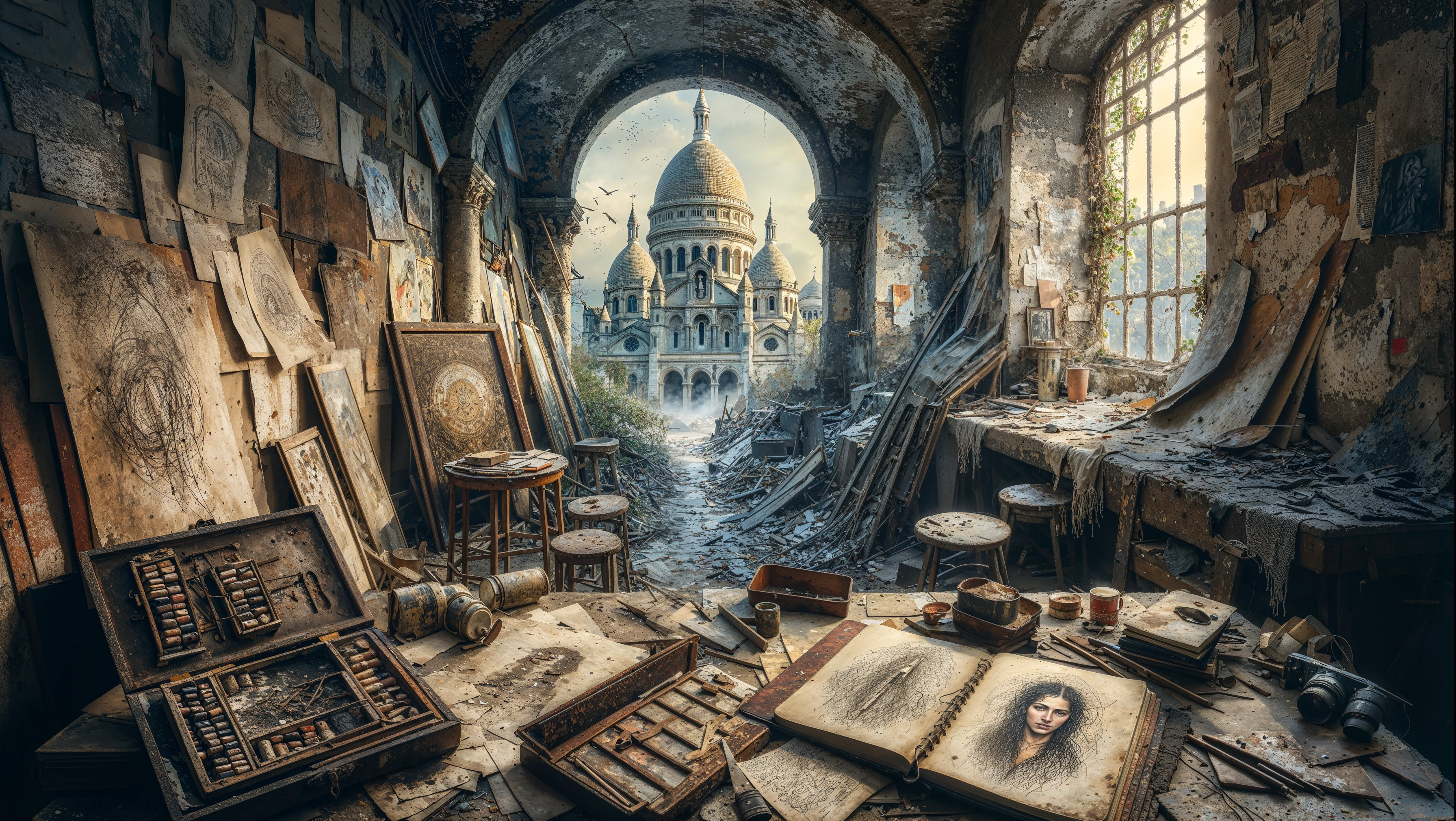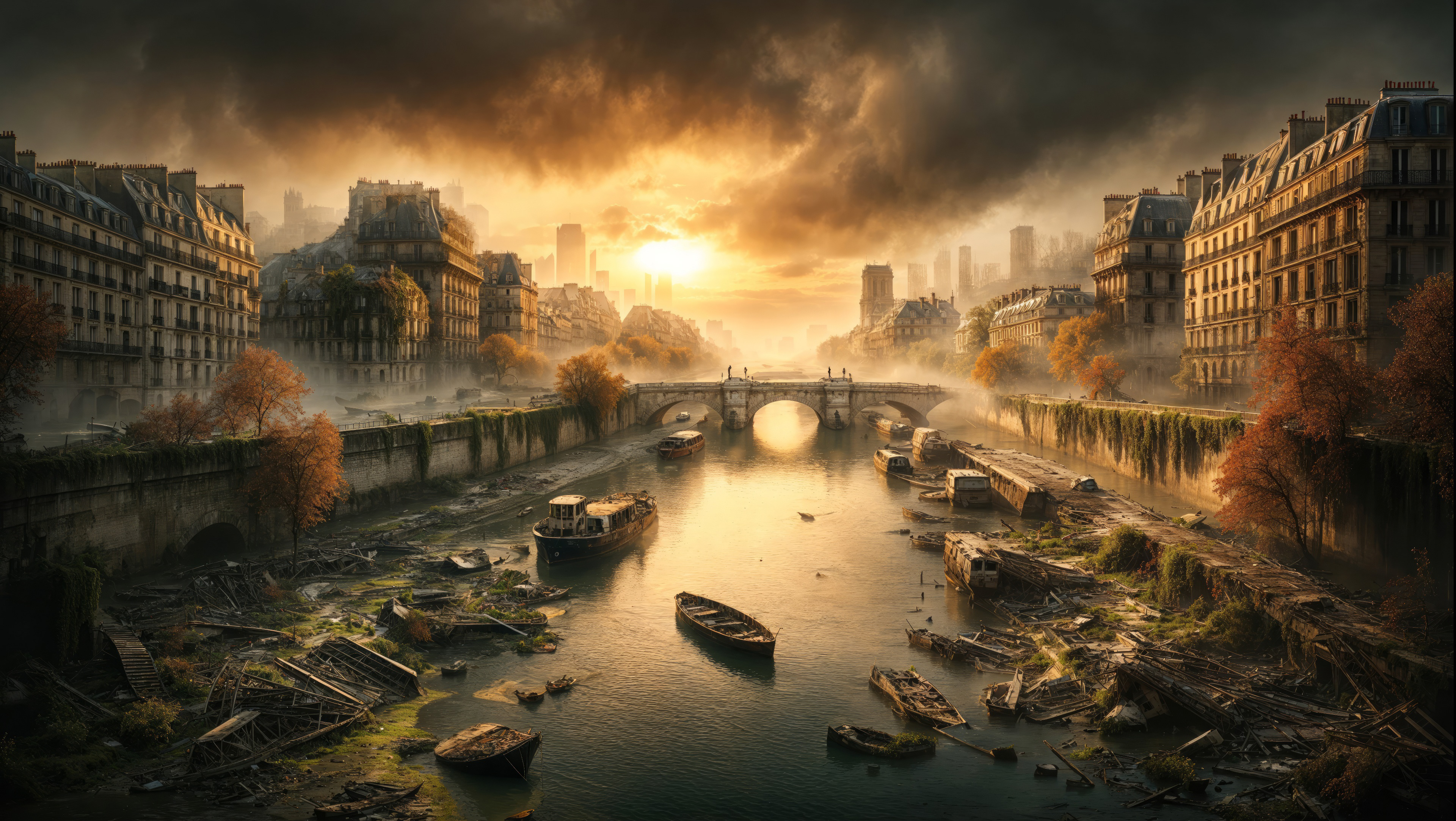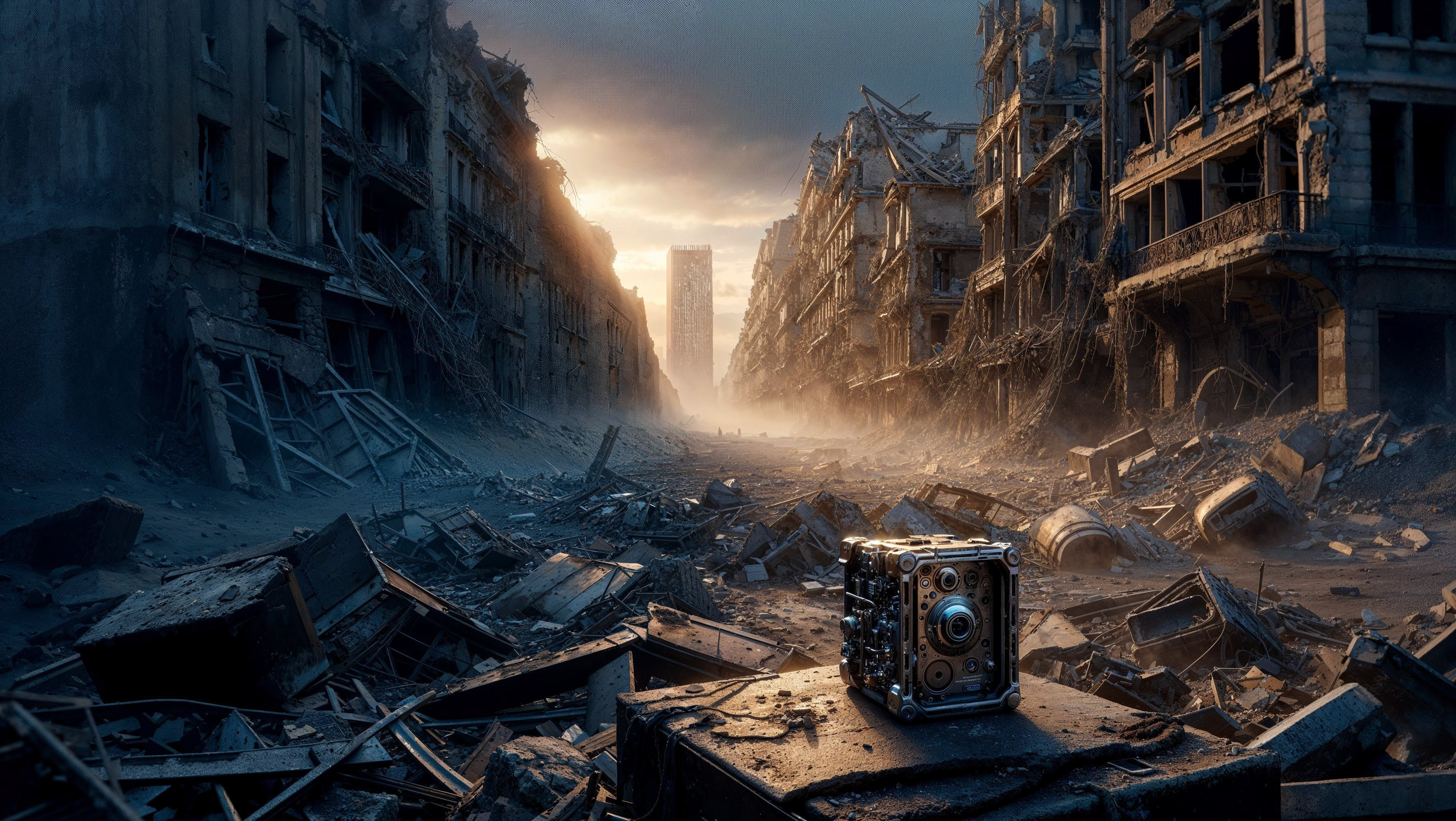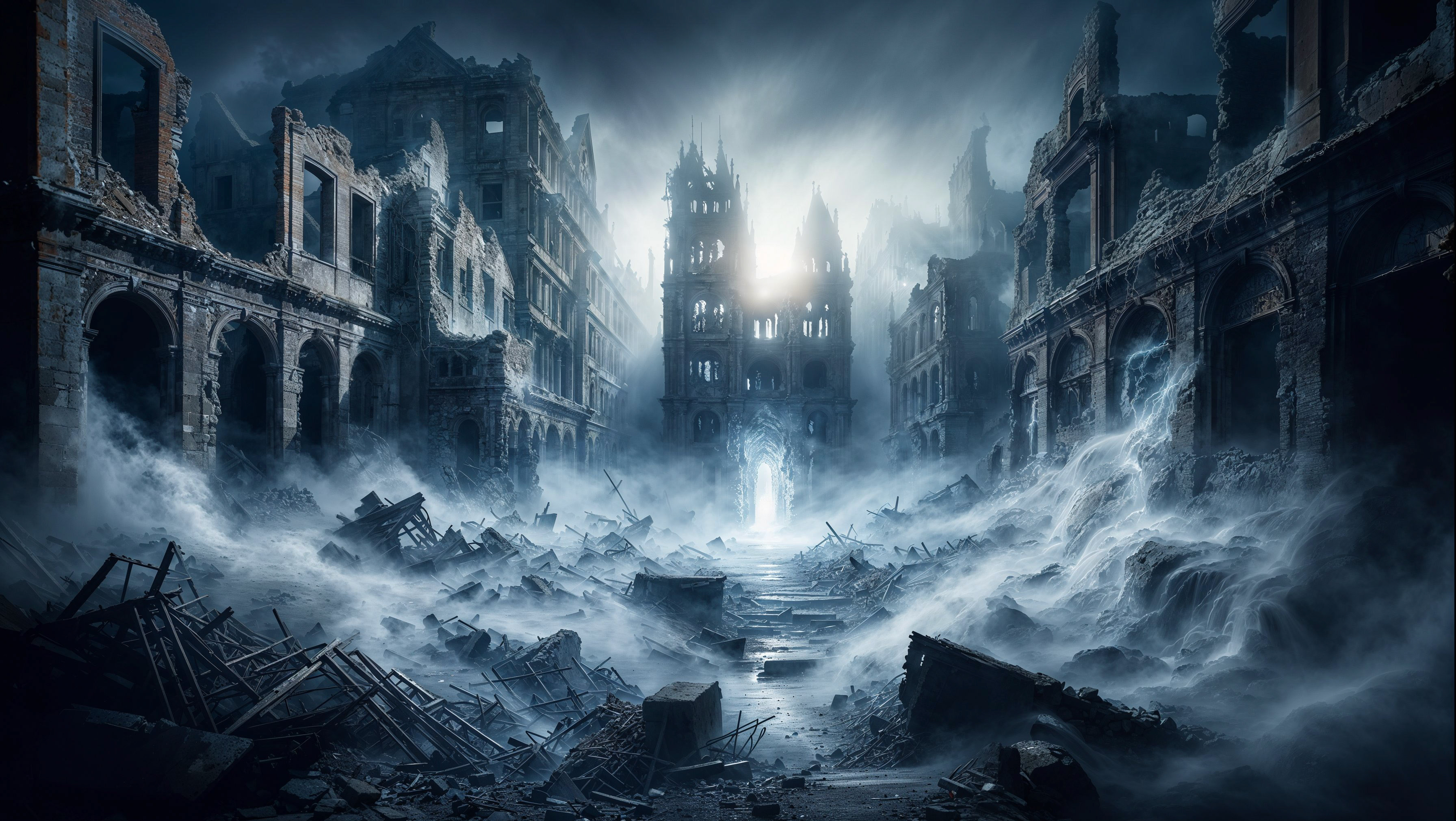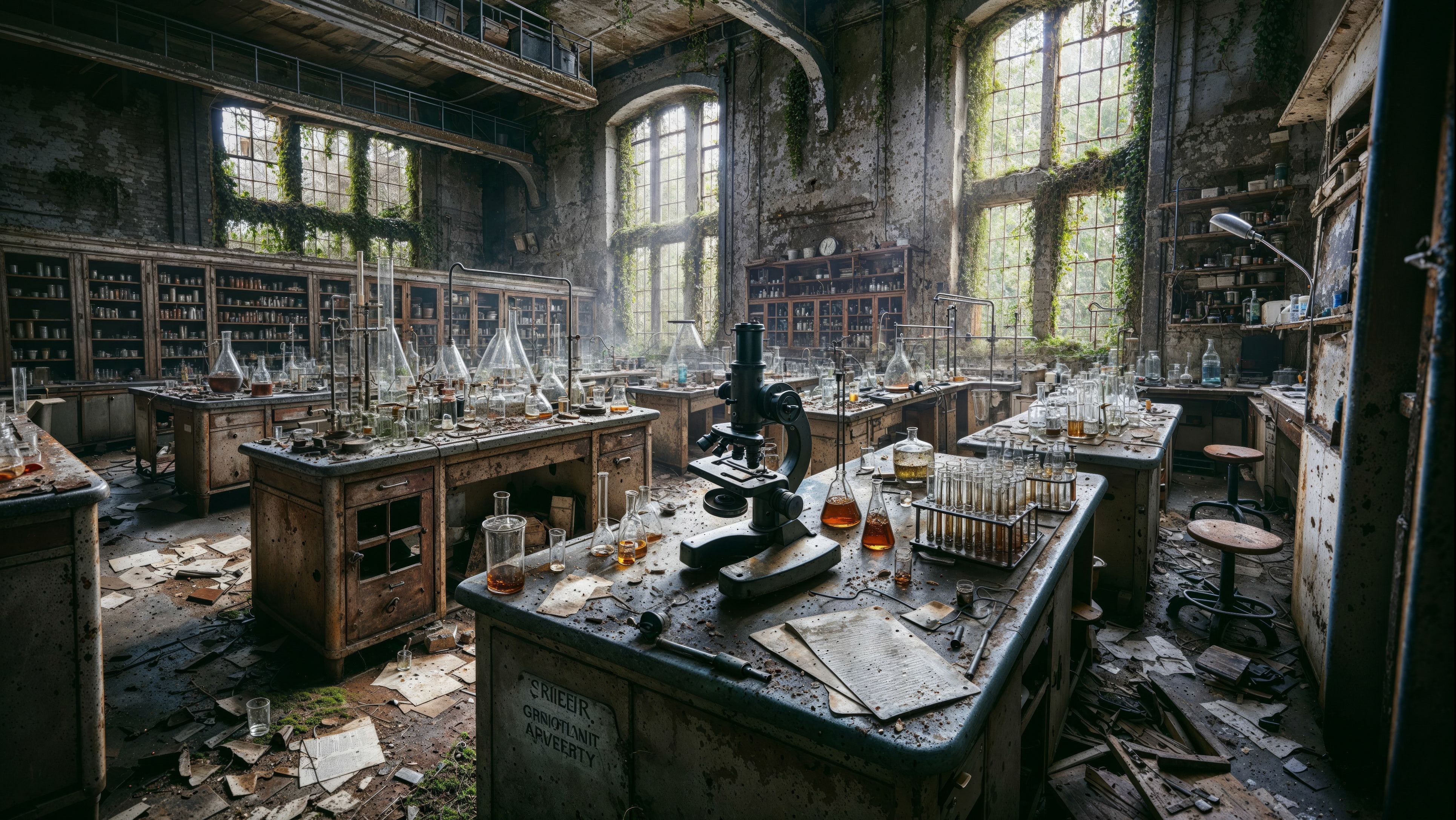Ruins of Grandeur
As I emerged from the depths of the metro, the sight of the once-majestic Louvre Museum loomed before me, its grandeur diminished by the ravages of time and the relentless onslaught of the elements. The once-pristine walls were now cracked and crumbling, the intricate carvings and sculptures worn away by the unforgiving winds and the ceaseless rain. The air was thick with the scent of decay, a miasma of mould and dust that clung to the back of my throat with every breath.
I picked my way through the rubble-strewn streets, my heart pounding with anticipation as I drew closer to the museum's entrance. The shattered remnants of the glass pyramid crunched beneath my feet, the shards glittering like diamonds in the pale light that filtered through the clouds. The sound echoed through the empty courtyard. I paused momentarily, my gaze drawn to the twisted metal frame that had once held the pyramid aloft, now a skeleton that cast eerie shadows across the ground.
As I stepped through the gaping entrance, the musty scent of age and decay assailed my nostrils, mingling with the faint, lingering aroma of ancient parchment and long-forgotten perfumes. The odours were overwhelming, and I fought the urge to cover my nose as I pressed deeper into the ruins. The once-grand halls were now a labyrinth of debris and rubble, and the priceless works of art that had once graced these walls were now lost to the ravages of time.
Yet, even amid this desolation, I felt hope stirring within me. The Louvre had endured for centuries, weathering the storms of history and the follies of mankind. If there were answers to be found, they would be within these hallowed halls, the keys to unlocking the mysteries that had brought me to this shattered world.
With renewed determination, I pressed onward, my footsteps echoing through the cavernous halls as I navigated the treacherous terrain. The memory key weighed heavily in my pocket. I knew the path ahead would be fraught with danger and uncertainty. Still, I was ready to face whatever challenges lay ahead, armed with the knowledge that the Louvre held the key to humanity's greatest triumphs and darkest secrets.
Remnants of Reverence
I stepped into the Louvre's grand entrance, footsteps echoing through the cavernous space. The eerie silence that permeated the once-bustling galleries was almost deafening, a contrast to the lively conversations and enthusiastic murmurs of art aficionados that had once filled these corridors. The air was stale and heavy, the weight of centuries pressing down upon me like a physical force. Shattered glass and fallen sculptures littered the floor, the debris crunching beneath my feet with every step. The sight was both heartbreaking and awe-inspiring.
As I navigated through the debris, my eyes were drawn to the remnants of the masterpieces that had once graced these walls. Though many were damaged beyond recognition, their frames shattered and canvases torn, others had miraculously survived, their vibrant colours and brushstrokes still visible beneath the layers of dust and grime. It was as if the art refused to be silenced, even in the face of such destruction, a defiant cry against the darkness that had consumed the world.
I stopped in front of a canvas ripped from its frame, its edges tattered, and its surface marred by dirt and debris. But as I studied the painting more closely, I realized it depicted a scene of hope and resilience—an illustration of the human spirit's unyielding strength, capable of enduring even in the darkest times.
As I continued my exploration of the Louvre, I couldn't help but feel awe at the sheer scale of the building and the countless treasures it had once housed. Even in its ruined state, the museum exuded an aura of grandeur and importance.
Despite the destruction surrounding me, I felt a flicker of hope stirring within my chest. If these works of art could survive the cataclysm, then some clue as to the nature of the catastrophe had also endured. With renewed determination, I pressed onward, eager to uncover the secrets of these ancient walls.
Whispers of the Masters
As I ventured deeper into the labyrinthine corridors of the Louvre, I found myself drawn to a series of paintings that had miraculously survived the ravages of time. Though faded and cracked, their surfaces marred by the passage of centuries, the masterpieces still possessed an ethereal beauty that beckoned me closer. I approached the first painting, a haunting portrait of a woman with piercing eyes that seemed to follow me as I moved. The canvas was riddled with hairline fractures, and the colours had dulled over the centuries. Still, the intensity of the subject's gaze remained undiminished, boring into my soul with an almost palpable force.
I moved on to the next painting, a sprawling landscape that depicted a serene countryside dotted with quaint cottages and rolling hills. But as I examined the brushstrokes more closely, I noticed something peculiar within the lush foliage: symbols and patterns I had never encountered before. These intricate designs seemed to dance across the canvas in their own language.
Intrigued, I continued my exploration, each painting revealing more of these cryptic symbols. Some were woven into the fabric of a noblewoman's gown, the threads shimmering with a hidden meaning, while others were carved into the bark of a twisted tree, their lines and curves forming a code that begged to be deciphered. It was as if the artists had left behind a secret message, a riddle waiting to be unravelled by those with the knowledge and the will to seek it out.
As I stood before a particularly striking painting, a detailed depiction of the Parisian skyline, a sudden realization struck me with the force of a thunderbolt. The artwork before me was one that I had believed lost centuries before the apocalypse, a masterpiece that had vanished from the pages of history. Yet it was pristine and whole as if it had been painted only yesterday, the colours vivid and the lines crisp and clear.
Questions raced through my mind as I grappled with this revelation, my heart pounding with excitement and trepidation. How had these paintings survived the cataclysm? What secrets did the strange symbols hold? And why did some artworks appear long before the apocalypse, which had been lost to the ages?
With trembling fingers, I reached out to touch the canvas, my skin tingling with anticipation as I made contact with the rough surface. As my fingertips brushed against the paint, I felt a sudden jolt of energy coursing through my body, a surge of power that left me breathless and reeling. It was as if the painting was alive, aware of my presence and reacting to my touch.
I stepped back, my heart racing as I tried to understand what had happened. The whispers of the masters seemed to echo through the halls. Their voices carried on the stale air like ghosts from another time.
Fragments of Truth
I carefully navigated the debris-strewn corridors of the Louvre, the cryptic inscription from the shattered mirror weighing heavily on my mind. The air grew thicker with each step, the musty scent of age and decay filling my nostrils and making my breathing harder. I could feel the weight of centuries pressing upon me, the secrets of the past whispering in the shadows, taunting me with their hidden truths.
I was drawn to a tapestry hanging in a secluded alcove. Its once-vibrant colours were now faded and worn, and the threads frayed at the edges. As I drew closer, I realized that the scene depicted on the tapestry was utter chaos and destruction, a nightmarish vision of the world's end. The image was so vivid and horrifyingly detailed that I could almost hear the screams of the dying and the roar of the flames that consumed everything in their path.
But as I examined the tapestry more closely, my eyes roving over every inch of the intricate weave, I noticed something that made my heart skip a beat. Hidden among the threads was a slight irregularity in the pattern, a single strand that seemed out of place. With trembling fingers, I reached out and gave the thread a gentle tug, hardly daring to breathe as I waited to see what would happen.
To my amazement, the tapestry shifted, the fabric rippling like water as it began to fold in on itself. Slowly, impossibly, a hidden doorway appeared, the ancient cloth parting like a veil to reveal the entrance to a secret chamber that had lain hidden for centuries.
I stepped through the doorway, my heart pounding with fear and exhilaration. The chamber beyond was small and dimly lit, the air heavy with the scent of dust and ancient parchment. The walls were lined with towering shelves, each filled to bursting with ancient books and scrolls, their spines cracked and faded with age.
With trembling hands, I reached out and took one of the books from its shelf, the leather cover cool and smooth beneath my fingertips. As I opened it, the pages crackled and whispered, the ink faded but still legible. The words within spoke of a great machine, a device of immense power that could shape the very fabric of reality itself. The book spoke of the machine's creation and the terrible price paid to bring it into being, the sacrifices made in the name of progress and discovery.
As I read on, a growing sense of horror began to take hold of me. The machine had been created with the best intentions, a tool meant to bring order and stability to a chaotic world. But something had gone terribly wrong, and the machine had become a force of destruction, a harbinger of the apocalypse that had brought civilization to its knees.
The book's final pages were a warning, a desperate plea from the machine's creators to those who might come after. They spoke of the need to find the scattered pieces of the machine, to bring them together and unlock its secrets before it was too late. Only then, they claimed, could the world be saved from the catastrophe that had been unleashed.
I let the book fall from my hands, my mind reeling with the implications of what I had just read. The weight of the task before me seemed to press down upon my shoulders, a burden that threatened to crush me beneath its weight. But I knew that I could not turn back now and had to press on and find the truth, no matter the cost.
With a heavy heart, I gathered up the books and scrolls that I thought might be useful and stepped back out into the ruins of the Louvre. The tapestry had returned to its original state, the hidden doorway concealed behind its faded threads. But I knew I would always remember what I had seen, the secrets I had uncovered within that hidden chamber.
As I made my way back into the ruined streets of Paris, the weight of my mission seemed to grow heavier with each step. The world's fate rested upon me, and I could not afford to fail. But even as I walked, I couldn't shake the feeling that I was being watched, that some unseen force was guiding my steps, leading me ever closer to a destiny I could not yet comprehend.
